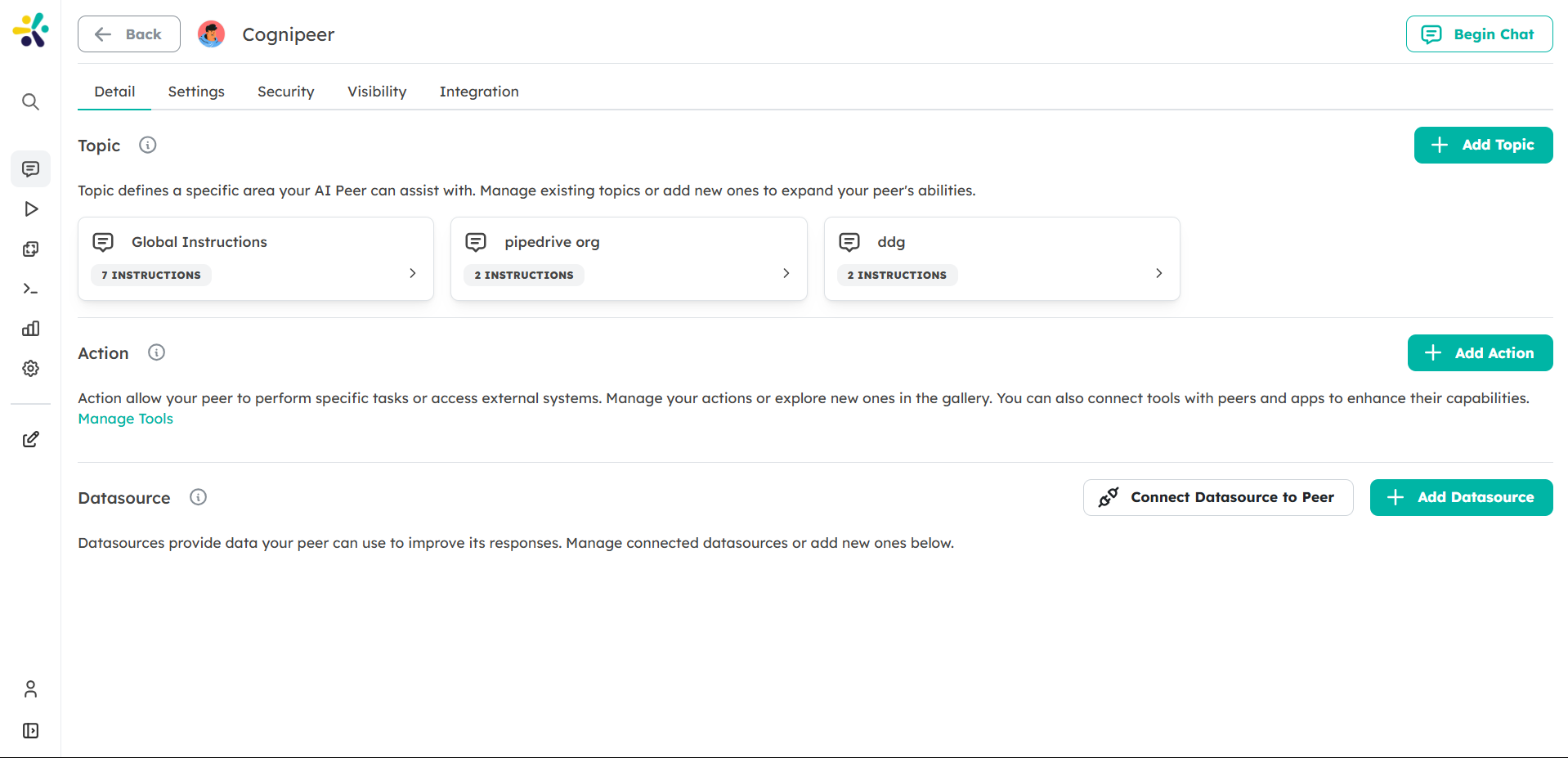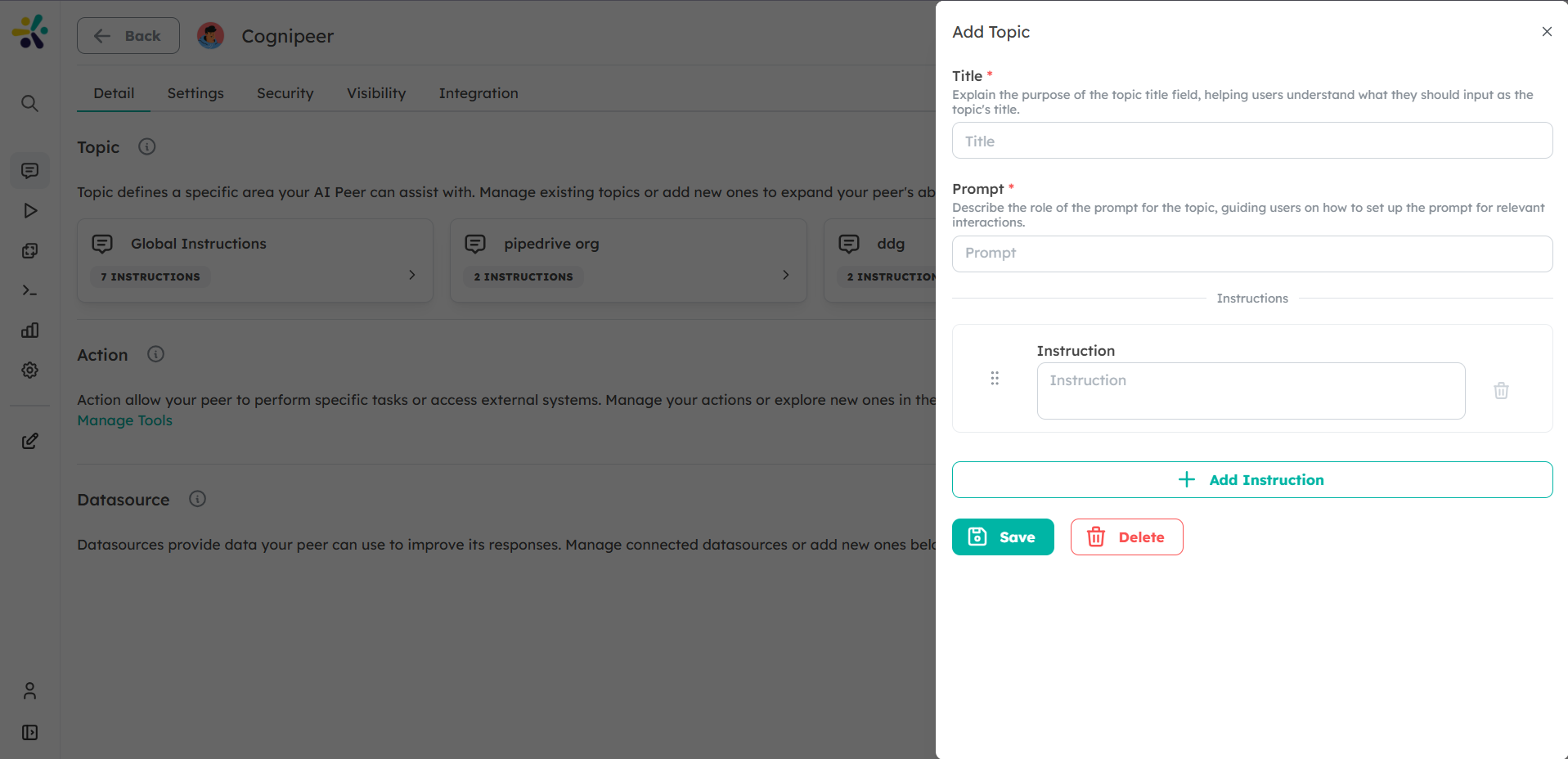Topics
A Topic in Cognipeer defines a specific area of expertise for your Peer. By creating and managing Topics, you can ensure that your Peers handle particular tasks or respond to specific inquiries with more accuracy and relevance. Topics allow Peers to specialize in different areas and focus their responses based on user needs.
What is a Topic?
A Topic is a structured set of instructions and guidelines that shape how a Peer interacts with users in a particular domain. Topics help segment the Peer’s knowledge, making it easier to customize the Peer's behavior based on specific user requests.
Creating a Topic
To create a new Topic for your Peer, follow these steps:
1. Access the Topics Section
Navigate to the "Topics" tab in your Peer’s settings. This section lists all existing Topics and allows you to add new ones.

2. Add a New Topic
Click on "Add Topic" to begin creating a new Topic. You will be prompted to fill in key information such as:
- Title: The name of your Topic (e.g., "Sales Assistance" or "Order Management").
- Prompt: A brief description of what the Topic will cover and how the Peer should handle tasks related to it.
- Instructions: Step-by-step guidelines for the Peer to follow when interacting with users under this Topic. These instructions help refine the Peer’s responses and ensure it behaves as expected.
- Actions: Define specific actions your Peer can take in this Topic, such as searching a knowledgebase or retrieving a document.

3. Example of a Sales Topic
- Title: Sales Assistance
- Prompt: You will handle tasks related to assisting users with lead qualification, product recommendations, and sales guidance.
- Instructions:
Guide users through the sales process step-by-step.
Provide tailored product recommendations based on the user's input.
Offer strategies to improve sales techniques and conversion rates.
Assist with lead qualification by analyzing potential leads.
Actions:
- Access the knowledgebase for product information.
- Retrieve and analyze sales documents uploaded by the user.
Topic Instructions and Best Practices
When crafting a Topic, the Instructions are critical as they outline how the Peer will handle specific tasks. Clear and concise instructions will help the Peer respond effectively and meet user expectations. Here are some best practices for creating effective Topic instructions:
Be Specific: Avoid vague instructions. Specify the exact steps the Peer should follow.
- Example: Instead of "Help with product inquiries", use "Provide product details based on the user's selection and recommend complementary products."
Use Actionable Steps: Break down complex tasks into smaller, actionable steps.
- Example: For a customer support topic, include instructions like "Guide users through troubleshooting steps for common product issues."
Incorporate User Input: Ensure the Peer adapts based on user feedback or questions.
- Example: For an HR topic, you might include "Adjust your response based on the employee’s role and seniority level within the company."
Leverage Peer Actions: Include Actions that allow the Peer to interact with external systems or retrieve data, like pulling information from a knowledgebase or reading uploaded documents.
Advanced Topic Customization
Cognipeer allows for deeper customization in how Topics are handled through advanced options:
1. Dynamic Prompts
A Dynamic Prompt allows your Peer to tailor its responses based on real-time information or user-specific queries. For example, in a Sales Topic, the prompt might include:
- "Analyze the uploaded sales data and provide recommendations for the next quarter." This ensures that the Peer can deliver more contextually relevant information.
2. Multiple Topics per Peer
Peers can handle multiple Topics simultaneously, allowing them to switch contexts based on user needs. You can manage the Topics' priorities so that Peers focus on the most relevant tasks first. For instance, a Peer with both a "Customer Support" and "Order Management" Topic can seamlessly switch between these functions based on the conversation.
Topic Example: Customer Support Peer
Here’s a detailed example of a Customer Support Topic for a Peer handling customer service inquiries:
Title: Customer Inquiry Handling
Prompt: You will handle customer inquiries, provide product information, and resolve issues efficiently.
Instructions:
- Answer customer questions regarding products and services.
- Provide troubleshooting steps for common issues.
- Offer support for account management tasks such as password resets and order modifications.
- Escalate complex issues to a human agent when necessary.
Actions:
Access product and order data from the knowledgebase.
Retrieve customer account details when requested.
Initial Prompts:
- "How can I help you with your product inquiry?"
- "Do you need assistance with your recent order?"
Editing and Managing Topics
You can edit existing Topics at any time by navigating to the "Topics" tab within the Peer’s settings. From here, you can:
- Edit the prompt, instructions, or actions.
- Remove outdated Topics or add new ones.
- Prioritize certain Topics to ensure they are handled first during interactions.
Topic Use Case: Multi-Topic Peers
Cognipeer Peers can excel in handling complex workflows by using multiple Topics. For example, a Customer Support Peer can manage both general inquiries and specific order-related tasks:
1. General Inquiry Topic
- Handles general customer questions about products and services.
2. Order Management Topic
- Assists customers with tracking, modifying, or canceling orders.
By assigning both Topics to a single Peer, you allow the AI to cover a wide range of scenarios in customer support, ensuring smooth and dynamic interactions.
Guides: How to Optimize Topics
1. Regularly Review Instructions
Keep your Topics updated based on user feedback and evolving business needs. Continuously refine the instructions to improve the Peer’s performance.
2. Use Knowledgebases and External Actions
Leverage the Actions section to connect your Peer to relevant external systems like knowledgebases, customer databases, or document repositories.
3. Create Specialized Topics for Different User Segments
For businesses with diverse user bases, create Topics that cater to different customer segments or departments. For example, separate Topics for Technical Support and Billing Support can ensure that each inquiry is handled by a specialized Topic, leading to more efficient and effective responses.
Conclusion
Topics are essential for customizing your Peer’s behavior and ensuring it delivers accurate, context-aware responses. Whether you’re creating Topics for sales, support, or HR, make sure to provide clear instructions and take advantage of the advanced options available in Cognipeer. By using Topics effectively, you can enhance your AI-powered Peers' performance and ensure they meet your business needs.
Start building your Topics today and unlock the full potential of your Peers!

